Private William George Turner
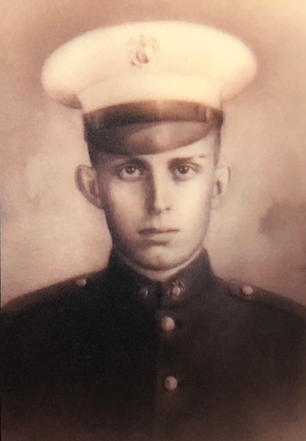
- Unit: Fleet Marine Force, 2nd Marine Aircraft Wing, Marine Aircraft Group 21
- Service Number: 303118
- Date of Birth: February 5, 1919
- Entered the Military: January 9, 1941
- Date of Death: December 12, 1941
- Hometown: Algona, Iowa
- Place of Death: Pearl Harbor, Hawai’i
- Award(s): Bronze Star, Purple Heart
- Cemetery: Section C, Grave 110. National Memorial Cemetery of the Pacific, Honolulu, Hawai'i
Mentored by Mr. Brian Connick
Algona Community School District
2020-2021
Early Life
William G. Turner’s life started in a small town in Kossuth County, Iowa. He lived at 303 West McGregor Street with his parents, H. Lafayette Turner and Jessie B. (Thackery) Turner, in Algona, Iowa. Jessie worked as a homemaker, and Lafayette was employed as a painter and decorator. Turner was the second oldest of four children in the family. William, who went by Bill, throughout school, and during his life, had an older sister, Ruth Elizabeth Turner, and two younger brothers, Robert Charles and Lee Eugene Turner.
During his freshman year of high school, he played football. As a sophomore, he shifted his focus and participated in track. By junior year, Turner participated on both teams. In 1936, he graduated from Algona High School at the age of 17.
Following graduation in 1939, he was a grocery store clerk, and he had an income of $864. Unfortunately, on March 10, 1940, his father passed away.
Turner enlisted in the U.S. Marine Corps on January 9, 1941.
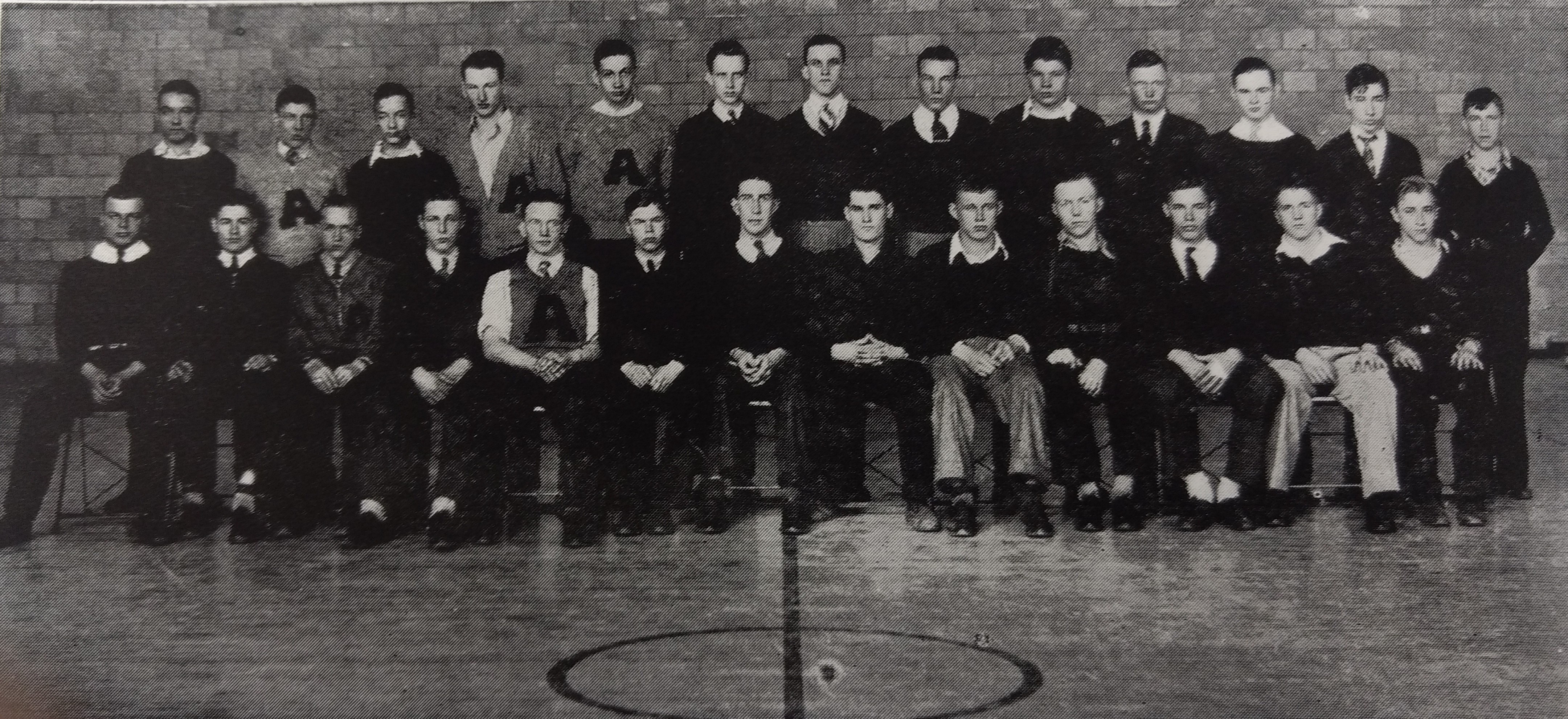
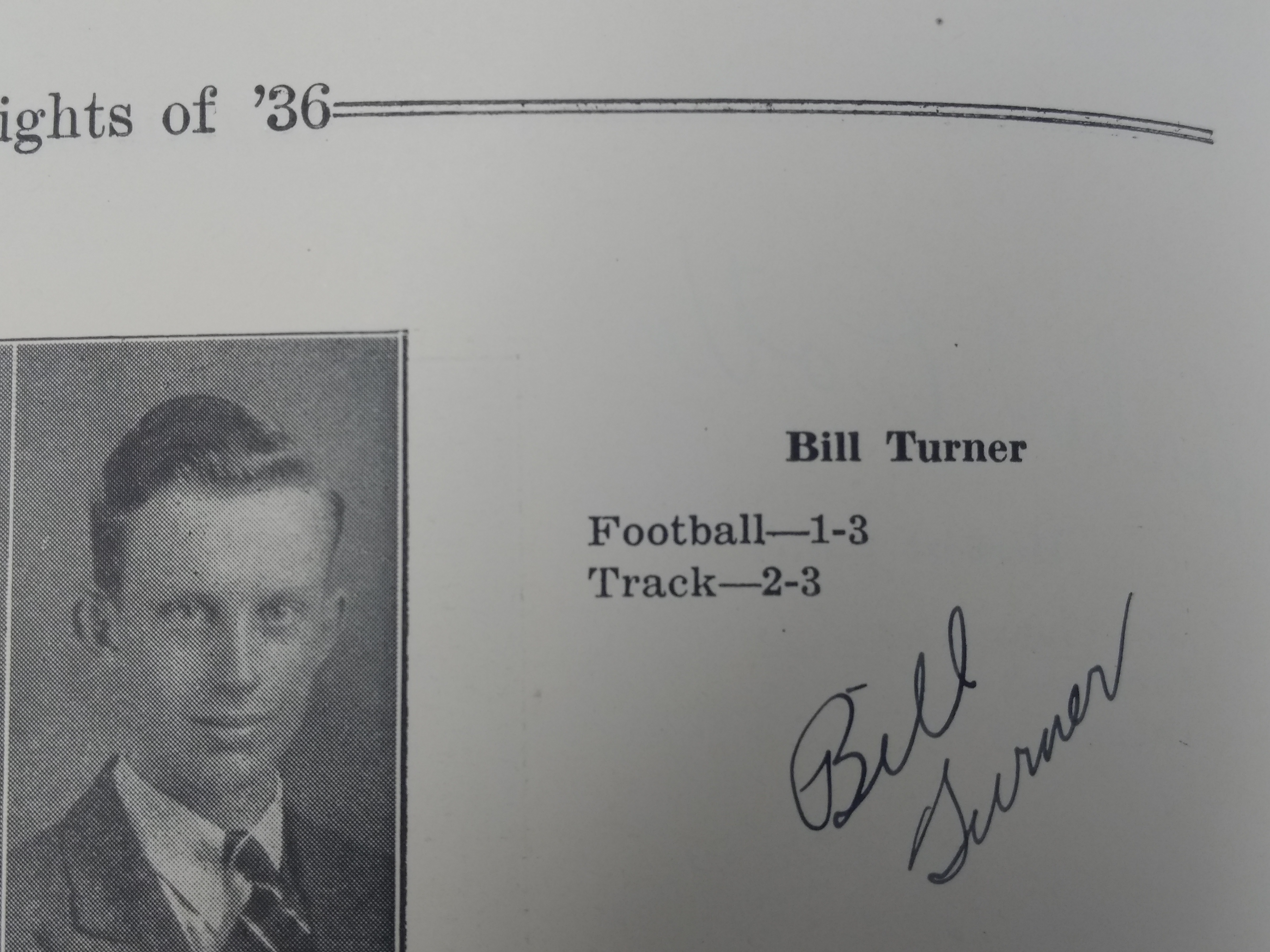
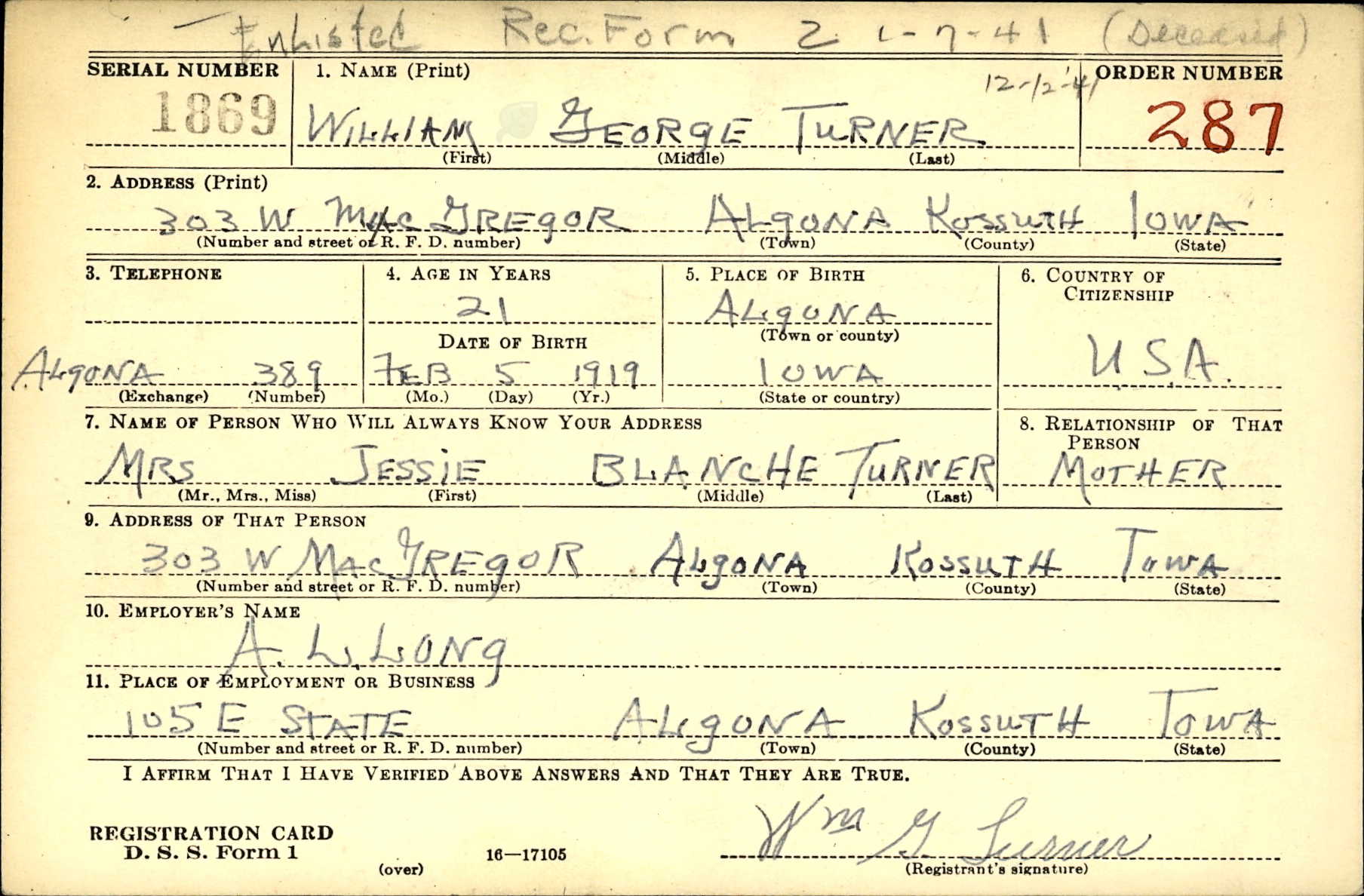
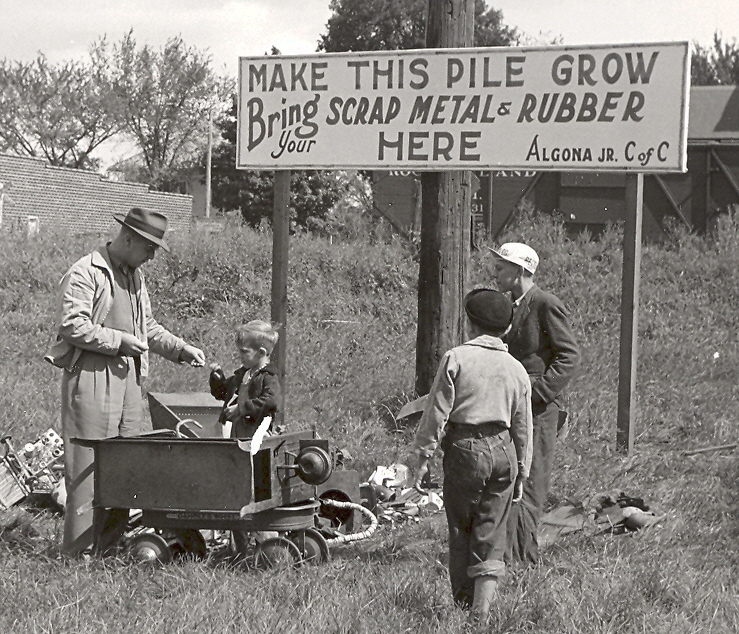
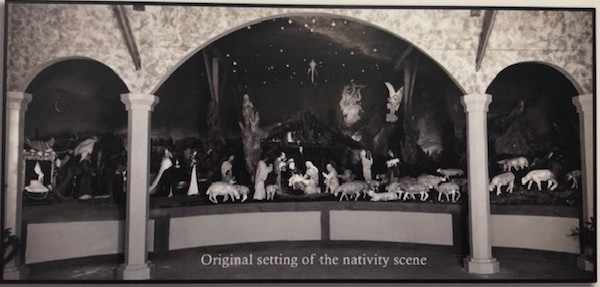
Homefront
Algona, a rural town, is located in northern Iowa. DuPont Pioneer Algona Corn Production facility, founded in 1938, remains the major business manufacturer in the area. They celebrated their 75th anniversary in 2013. The business provided many with jobs during the Great Depression.
Pioneer, an agricultural business, specializes in the research and production of hybrid corn and soybean seeds. During World War II, almost all of the plant’s jobs had to be done by hand, as this served as the standard means of gathering corn. Mechanical corn picking machinery had just started to hit the local market when the Pioneer plant’s construction began.
Algona served as a headquarters location for Prisoner of War (POW) camps in the upper Midwest. Construction began in Turner’s hometown in 1943, as workers built the German POW camp, known as Camp Algona. Around 10,000 German POWs stayed at the camp during its operation, where “[t]he average monthly population was 3,216.” In the “Interviews and Memories of German POWs” with former POW Alfred Mueller, he said “…the prisoners received plenty of food,” and “…received pay at 10 cents an hour in coupons…” The jobs of the POWs ranged from detasseling and weeding fields to working in the cold storage facility where the camps items such as dairy and other goods were kept. They used their coupons to exchange for essentials or products they wanted. The camp even had a movie theater that was open to the POWs and an orchestra in which they could participate.
POWs at Camp Algona, which included Edward Kaib, Horst Wendlandt, and four other men, built a 65-piece Nativity scene during their free time. When World War II ended, the men donated their half-life-sized figures to the town of Algona. The figures are currently under the care of the First United Methodist Church in Algona, Iowa, and it can still be seen and visited during the holiday season today.


Military Experience
Turner decided to enlist in the U.S. Marine Corps on January 9, 1941. Following military approval, he traveled to the Naval Air Station in San Diego, California, for basic training on January 11, 1941. Upon arrival, recruits receive their first meal, dog tags, identification cards, and service numbers. They were also given hair cuts and issued clothing, combat gear, and rifles along with their paperwork.
Naval Air Station, San Diego, had a seven-week long training process. Each man spent 151 hours in weapons training, 24 hours in physical training, 93 hours in garrison training, and 54 hours in-field training. Collectively, the men spent 322 hours in training for over seven weeks.
Turner trained as a radio operator and was assigned to Fleet Marine Force, 2nd Marine Aircraft Wing, Marine Aircraft Group 21 on the island of Oahu in the Territory of Hawaii. He was stationed here through December 7, 1941.
Like many others, he leaped into action on December 7, 1941, when the Japanese attacked Pearl Harbor. Stationed at Ewa Marine Corps Air Station, Turner experienced much of the attack’s turmoil and chaos. In the book, Day of Infamy, Walter Lord explained “Sergeant Emil Peters and Private William Turner operated a machine gun in one of the disabled planes…” Turner supplied ammunition belts to Sergeant Emil Peters, who fired a machine gun from one of the disabled SBD Dauntless dive bombers in Ewa Mooring Mast Field. While under fire from Japanese planes, Turner was shot in the abdomen. He died a few days later at Ewa Plantation Hospital, on December 12, 1941.
His heroic actions did not go unnoticed. His military records revealed that he was “…recommended posthumously for Navy Cross for action on 7 December 1941.” He did received a Bronze Star.
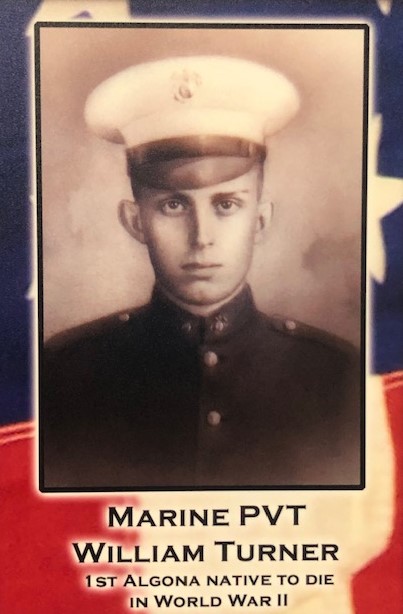
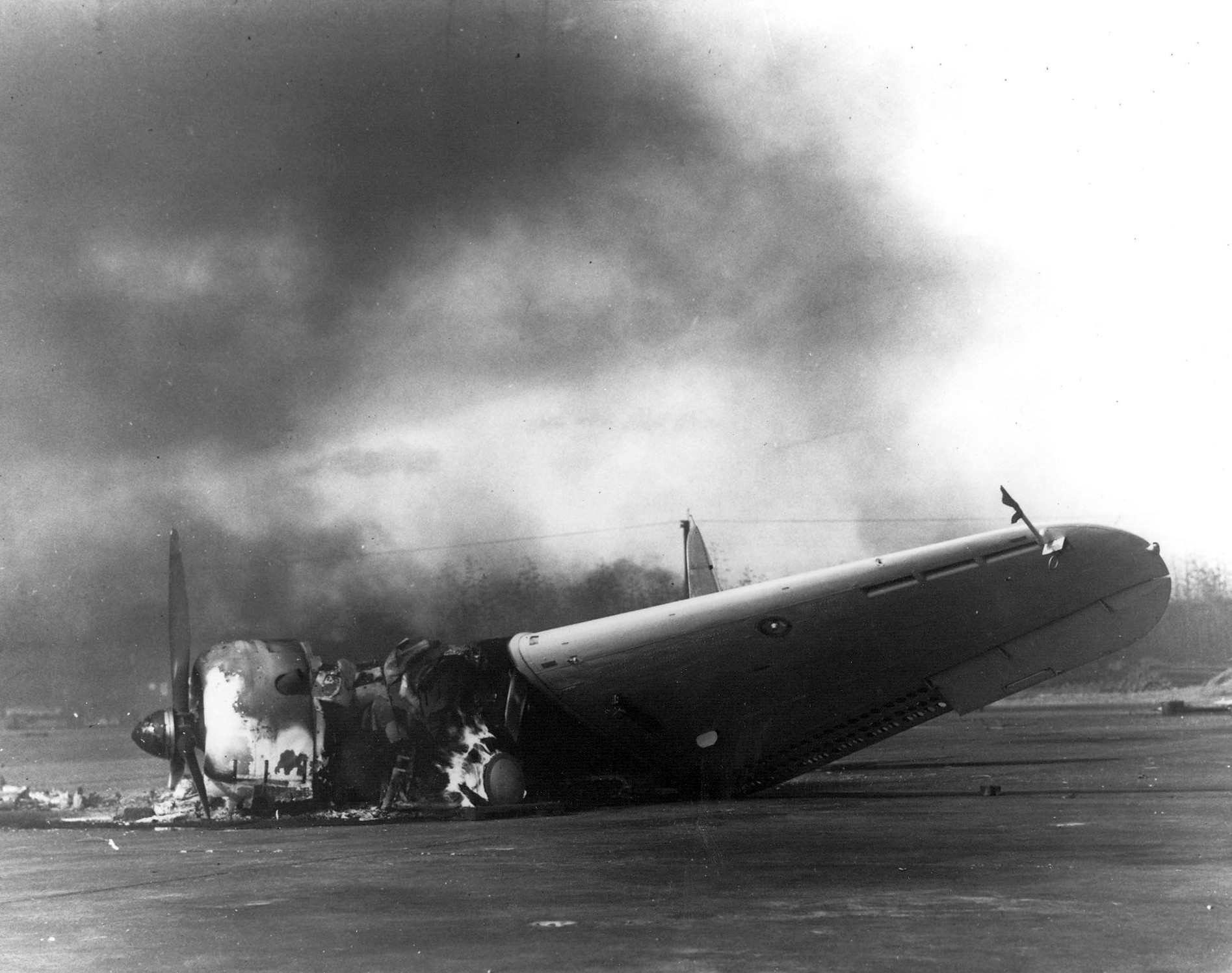
Eulogy
Kossuth County, the largest county in Iowa, is home to a small rural community, Algona. The town was no stranger to helping the war effort.
Like many others across the county, this small town was home to brave men and women answering their country’s call. Kossuth county had around 2,600 men and women that left their loved ones and homes behind to defend and protect what they hold dear. Among them, 113 gave the bravest sacrifice, their lives.
On January 9, 1941, Private Turner enlisted in the U.S Marine Corps and completed basic training in San Diego, California. Once he completed training, he was assigned to Fleet Marine Force, 2nd Marine Aircraft Wing, Marine Aircraft Group 21, Scout-Bombing Squadron 231 in Ewa, Hawai’i. The Scout-Bombing Squadron 231 went by the nickname the Ace of Spades. Even after getting re-designated over the years, the squadron was known as the Ace of Spades.
On December 7, 1941, part of Scout-Bombing Squadron 231 was aboard the aircraft carrier USS Lexington, while Private Turner, Sergeant Emil Peters, and others, were held in reserve in Hawai’i. As the Japanese attacked Oahu, Private Turner and Sergeant Peters leapt into action. Private Turner supplied ammunition belts to Sergeant Peters, who fired at the Japanese. They were responsible for shooting down at least one Japanese zero and possibly two. Unfortunately, this heroic act cost Private Turner his life. Shot in the abdomen, he died on December 12, 1941.
During the attack on Pearl Harbor, parts of his Scout Bombing Squadron, 231, were aboard the USS Lexington and not on the island. They served at the Battle of Midway. The letter, published in The Globe Gazette in Mason City, Iowa, Saturday, February 21, 1942, stated, “It is needless to say that your great loss was our great loss, and we, of this group, are all very proud to have known William as the fine upstanding American boy that he was.”
May Private Turner forever rest in peace.
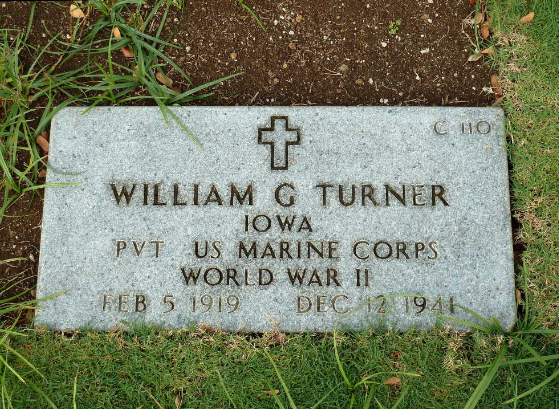
Reflection
I can truly say that the Sacrifice For Freedom®: World War II in the Pacific is a dream I thought might never come true. With all the uncertainty the pandemic brought, no one could say whether or not this trip could go on. Once we landed, and I was given my first ever lei, I could finally process that I was standing in Hawaii with all of the people who have worked so hard to be there.
When we visited the USS Arizona memorial and saw the countless names, it gave a better perspective on the magnitude of the attack on Pearl Harbor. When reading a textbook, it is easy to forget that the casualties you have learned about are not just numbers. Every one of those people has a story to be told, and the Arizona was one of many areas in Pearl Harbor that lost brave lives that day.
As I look back and remember approaching the USS Missouri, it was a very breathtaking experience. I was walking up to the very place where so many prayers for the war to end were answered. When I walked through the magnificent ship, I could not help but get goosebumps. A memory I know I will never forget is when a few of the students had the honor of taking down the U.S. flag and raising it the following morning. I cannot even come close to imagining what it would have been like to work and live on the ship. Throughout the encampment, it gave me a deeper understanding of how it possibly would have been for the sailors. It gives me even higher respect for the men and women who serve in the U.S. Navy.
During the trip, we had the honor to go to Hickam Air Force Base. When we were on the grounds, it was a constant reminder of the lives lost during the attack on Pearl Harbor. The damage done during the attack can still be seen in numerous places. I will never forget walking up to touch the damaged sides of the living quarters and getting to touch history. While we were standing on the very ground where brave men and women fell, it was hard to keep from being emotional. All of the people who passed had their own stories, hopes, and dreams. As I spent two years researching Private William G. Turner, I started to feel as though I knew him. Once I made it to the National Memorial Cemetery of the Pacific, I was very honored to present his story and let him know he hasn’t been forgotten. I was able to walk to his headstone and have a moment to myself with him. I thanked him for his bravery. I can better understand how he might have felt being so far from home through traveling the same distance. I understand now what it feels like to be so far from our corn and bean fields of Iowa. I hope he can rest easy knowing that his sacrifice does not go unnoticed. Through all of my experiences on this trip, I have found so much more I can do to help others tell their story.
Bibliography
Primary Sources
Destroyed SBD Ewa 7 Dec 1941. Photograph. December 7, 1941. U.S. Navy National Museum of Naval Aviation (1996.488.029.040). commons.wikimedia.org/wiki/File:Destroyed_SBD_Ewa_7_Dec_1941.jpg.
Hellmich, Richard. “Sharing ‘Pioneer Reflections,’” 2001. The Pioneer Company, Algona, Iowa.
Iowa. Kossuth County. 1925 State Census. Digital Images. ancestry.com.
Iowa. Kossuth County. 1920 U.S. Census. Digital Images. ancestry.com.
Iowa. Kossuth County. 1930 U.S. Census. Digital Images. ancestry.com.
Iowa. Kossuth County. 1940 U.S. Census. Digital Images. ancestry.com.
[Letterman’s Club, Algona High School]. Photograph. 1936. Courtesy of Alonga High School.
[Nativity Scene]. Photograph. 1943-1946. Camp Algona Collection.
[Private William Turner in uniform]. Photograph. 1941. Camp Algona Collection.
Private William G. Turner, USMC. Photograph. 1941. National Personnel Records Center, St. Louis (NH 102279). www.history.navy.mil/content/history/nhhc/our-collections/photography/numerical-list-of-images/nhhc-series/nh-series/NH-102000/nh-102279-private-william-g–turner–usmc.html.
William G. Turner. Navy, Marine Corps, and Coast Guard Casualties, 1941-1945. Digital Images. ancestry.com.
William G. Turner. U.S. Navy Casualties Books, 1776-1941. Digital Images. ancestry.com.
William George Turner. Iowa, World War II Bonus Case Files, 1947-1959. Digital Images. ancestry.com.
William George Turner. Iowa, World War II Bonus Case Files for Beneficiaries, 1947-1959. Digital Images. ancestry.com.
William George Turner. Honolulu, Hawaii, National Memorial Cemetery of the Pacific (Punchbowl), 1941-2011. Digital Images. ancestry.com.
William George Turner. World War II Draft Cards, Young Men, 1940-1947. Digital Images. ancestry.com.
William Turner, Individual Deceased Personnel File, Department of the Army.
William Turner, Official Military Personnel File, Department of the Navy. U.S. Marine Corps, Record of the U.S. Marine Corps, RG 127, National Archives and Records Administration – St. Louis.
[Scrap Drive]. Photograph. 1942. Camp Algona POW Committee.
Senior-class. “Highlights of ’36,” 1936. Yearbook. Algona High School.
Secondary Sources
“About.” Camp Algona. Updated 2019. Accessed September 20, 2020. www.pwcampalgona.org/about.
“Basic Training in the USMC during World War II.” Weston D. Eastman. Modified July 3, 2018. Accessed October 24, 2020. wdeastman.com/basic-training/.
Becker, Sharon R. and Pat Holt Juan. “WWII: Kossuth County, Pvt. William G. Turner.” IAGenWeb Project. Updated February 2020. Accessed October 24, 2020. iagenweb.org/wwii/WWIISurnamesS_T/TurnerWilliamG.html.
Heinl, Jr., Lieutenant Colonel R. D. Marines at Midway. Washington, D.C.: U.S. Marine Corps, 1948. www.ibiblio.org/hyperwar/USMC/Midway/USMC-M-Midway-3.html.
Henkels, Jack G. “William George Turner, Ewa Marine Corps Air Station.” Gone but not Forgotten. Accessed October 24, 2020. gonebutnotforgotten.homestead.com/TurnerWilliam.html.
Lord, Walter. Day of Infamy. New York: Henry Holt and Co, 2012.
“Private William G. Turner, USMC.” Naval History and Heritage Command (NH 102279). Accessed October 24, 2020. www.history.navy.mil/content/history/nhhc/our-collections/photography/numerical-list-of-images/nhhc-series/nh-series/NH-102000/nh-102279-private-william-g–turner–usmc.html.
“VMA-231 HISTORY,” U.S. Marine Corps. Modified 2009. Accessed December 10, 2020. www.mag14.marines.mil/Portals/20/Documents/VMA231/231History2009.pdf.
Yocum, Jerry. ‘Pass in Review‘, 2012. Camp Algona Museum.

